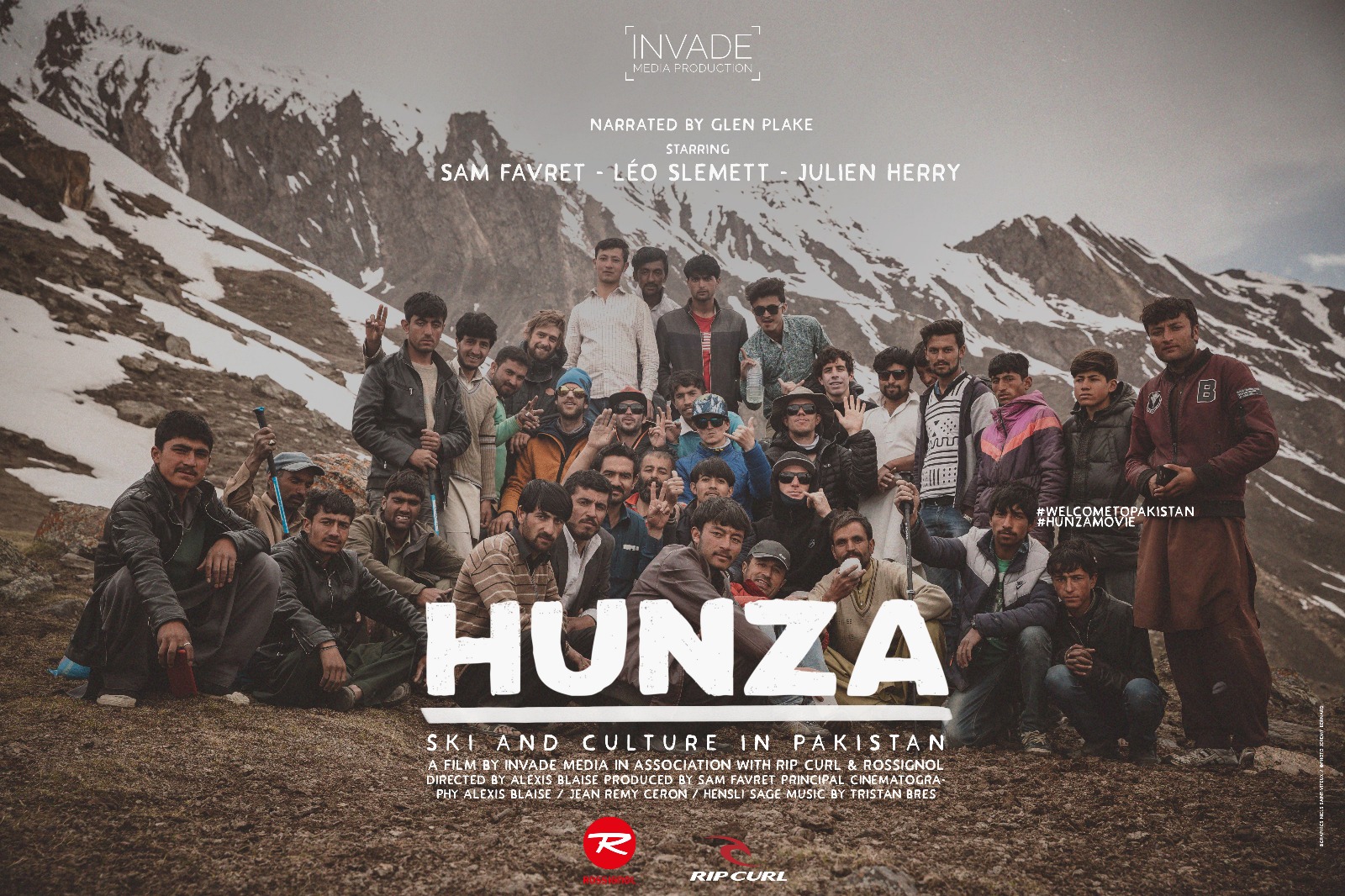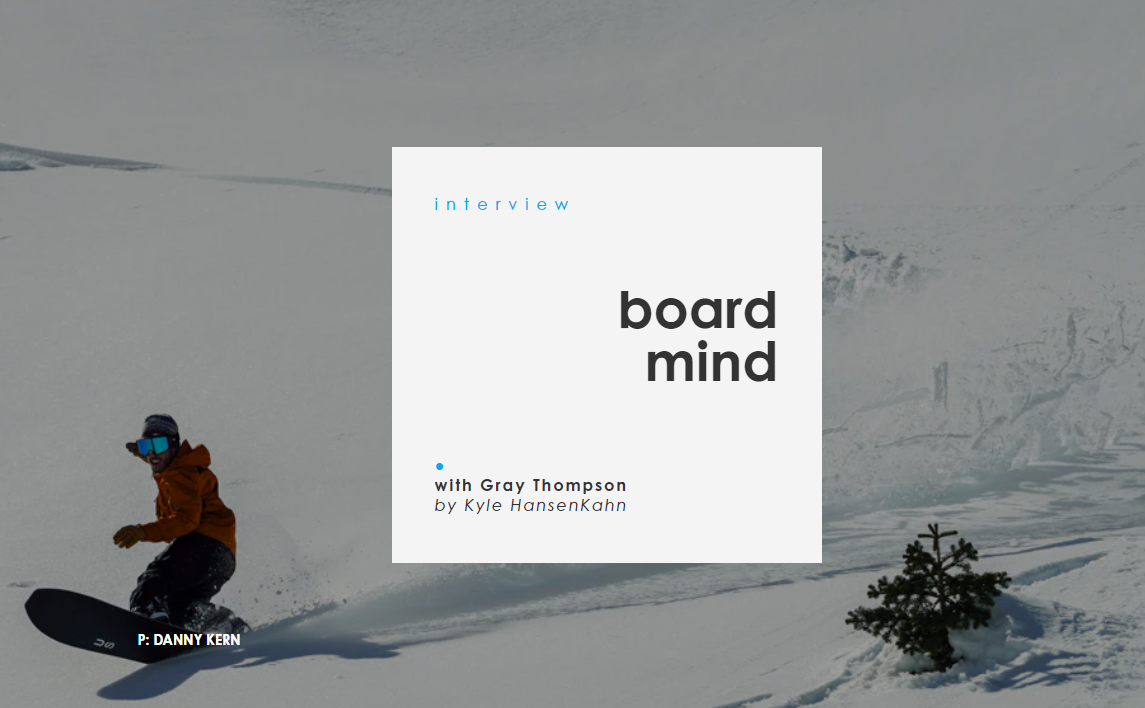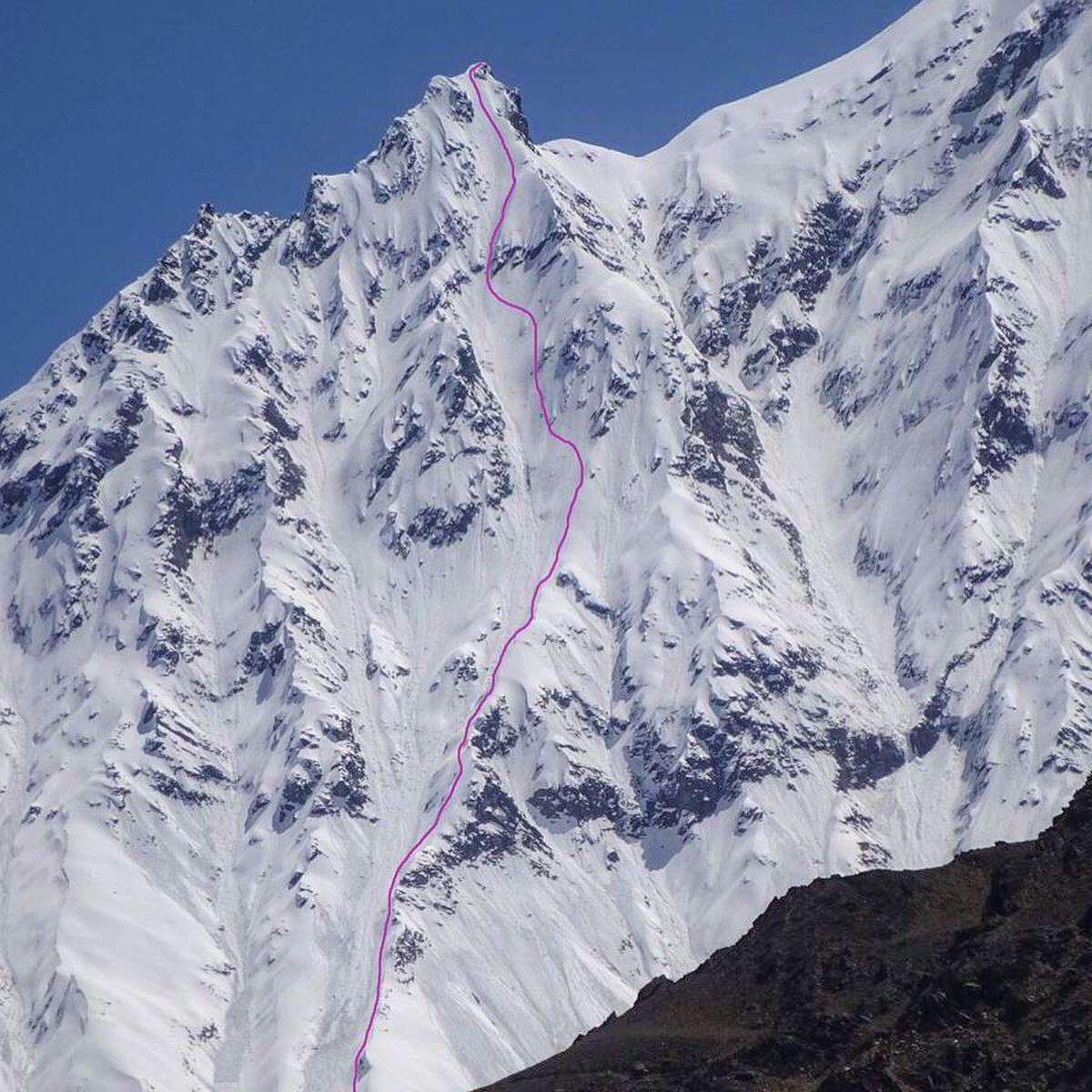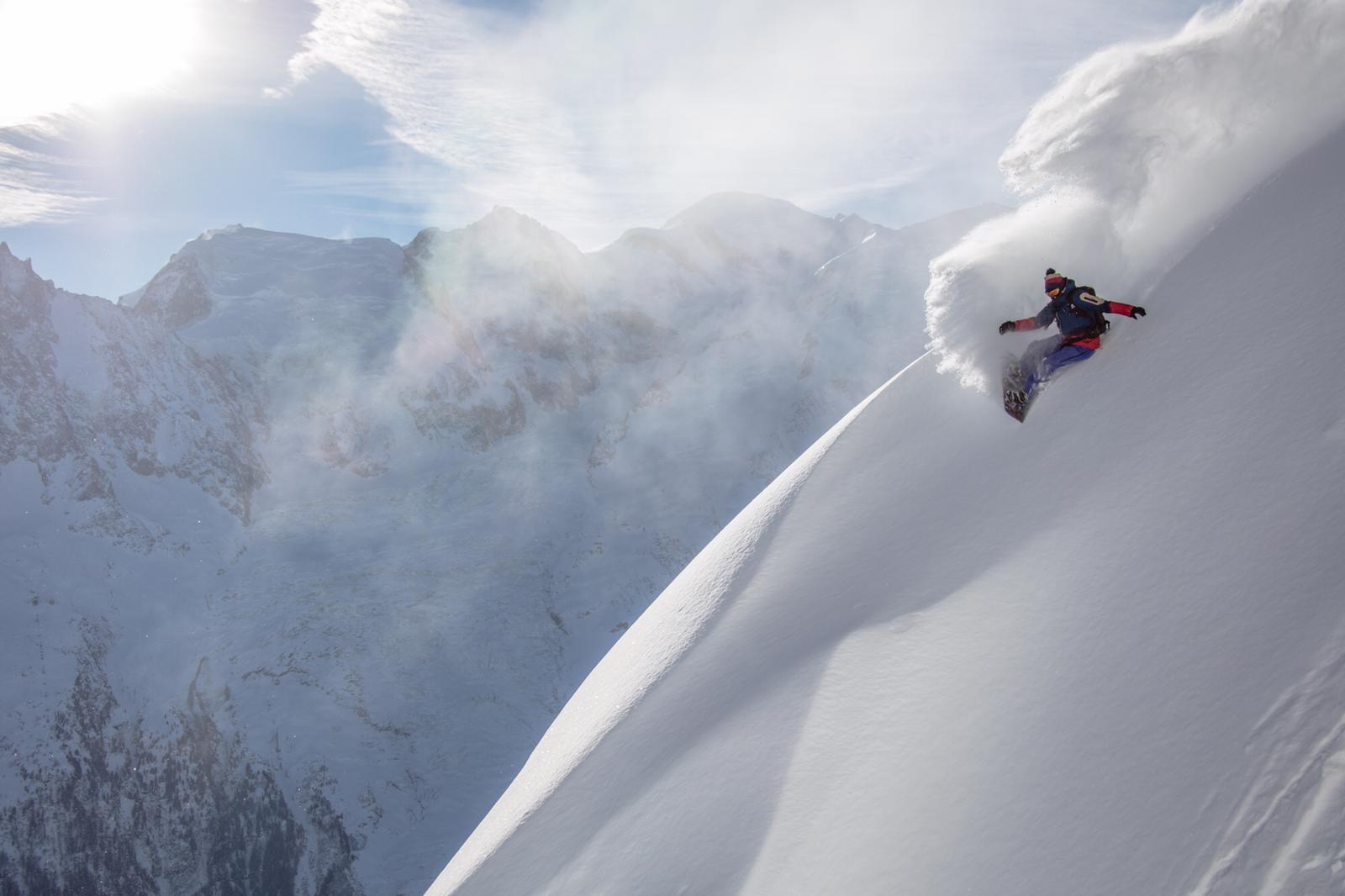
Pica, shredding the Brevent side of the Chamonix Valley. Photo: Arthur Ghilini
We’ll begin this by rehearsing the fact that Julien Herry of Chamonix might just be the best “Steeps Specialist” snowboarder in a generation of riders. He has put down first descents throughout the European Alps, and has honed his skillset as a snowboard alpinist to levels that most of us generally only fantasize about. To ride the terrain that “Pica” does, is to step into another universe in which there is an extra dimension of vertically oriented spacetime.
This past spring he took his unbelievably refined skillset to the mighty Karakoram Mountains of Pakistan. Pica and his partners made phenomenal documentary of their adventure, and the link is posted below. For those interested in Julien’s first hand account, we’ll let him express his experience in the text that follows. Photos are by his friend Jeremy Bernard. – Russell
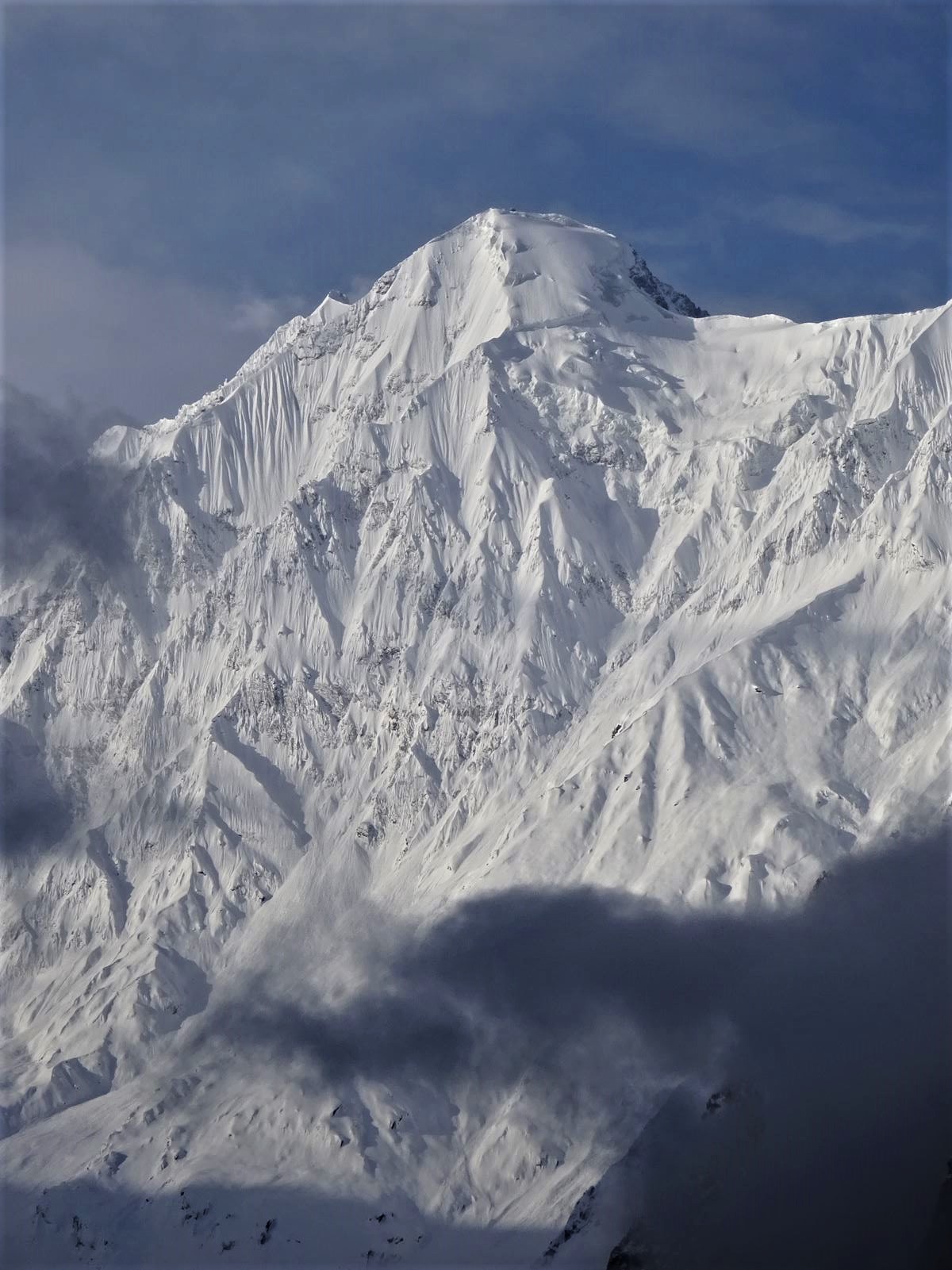
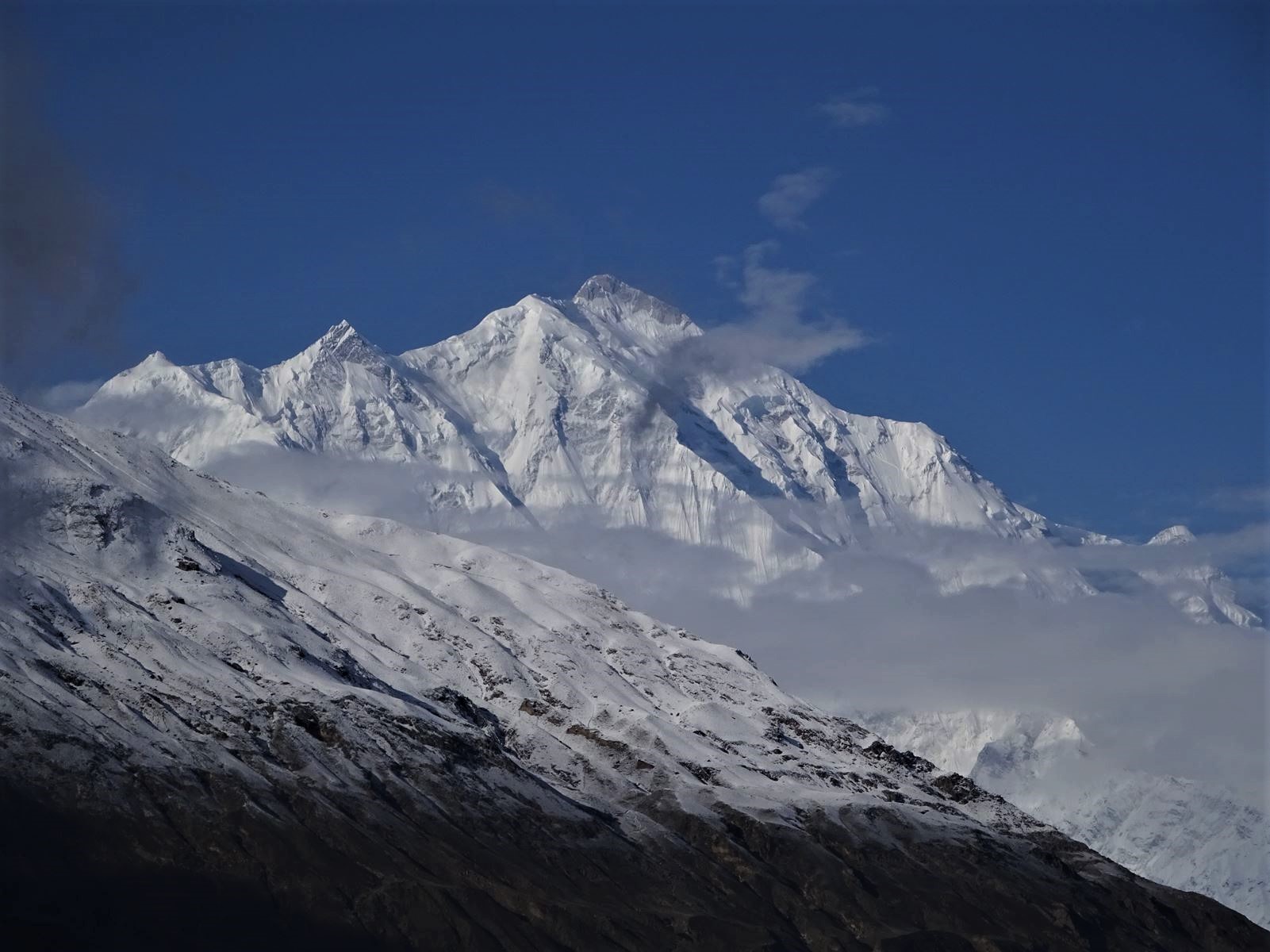
Photo: Jeremy Bernard
On the last day of April 2018, at 10am, we are standing on the summit of Barbara peak (5520m) with an incredible 360 degrees view on the Karakoram range. There is not a cloud in the sky, the temperature is warm and there is nobody around. We can profit as much as possible of the simple pleasure of being there, having the chance to live our dreams fully. That same morning Léo, Sam and I left base camp around midnight and hiked for 4 hours under the full moon before the day light came as we were changing skins for crampons. Finishing that first ridge with the sunrise over Hispar glacier was unreal and the following hours of hiking felt a bit dreamy with the help of altitude, mixing feelings and memories. I first came on these slopes with my best friend Max in spring 2008. We waited for an hour in the storm on a shoulder at 5100m for the weather to clear and allow us to ride on sight an amazing glacier just below. The weather never cleared and we were forced to ride down following our climbing track on more mellow terrain. Unfortunately Max lost his life a few years later when guiding clients in the Mont Blanc range. In 2012 I was back on the same slopes with some friends and enjoyed an emotional tribute to Max when spraying his ashes on that same shoulder, in this place he was feeling so alive. This time we got lucky to ride the glacier with clear blue sky and perfect snow conditions.
Back to this spring’s dreamy hike between smiles and tears, we finally get back to reality when suddenly getting lost on the mountain, trying to figure out where we are.
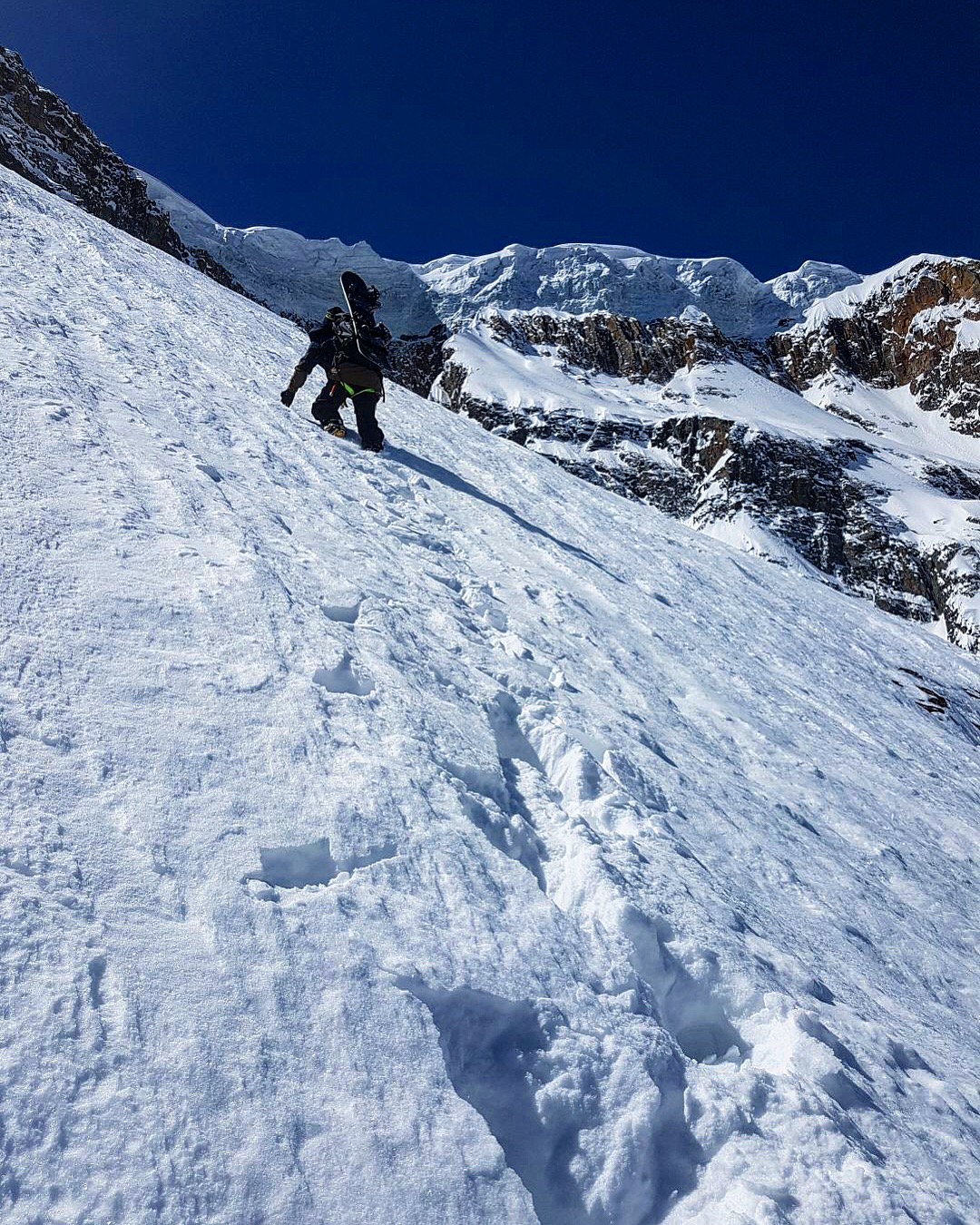
Barbara Peak, East Face, 5520m:
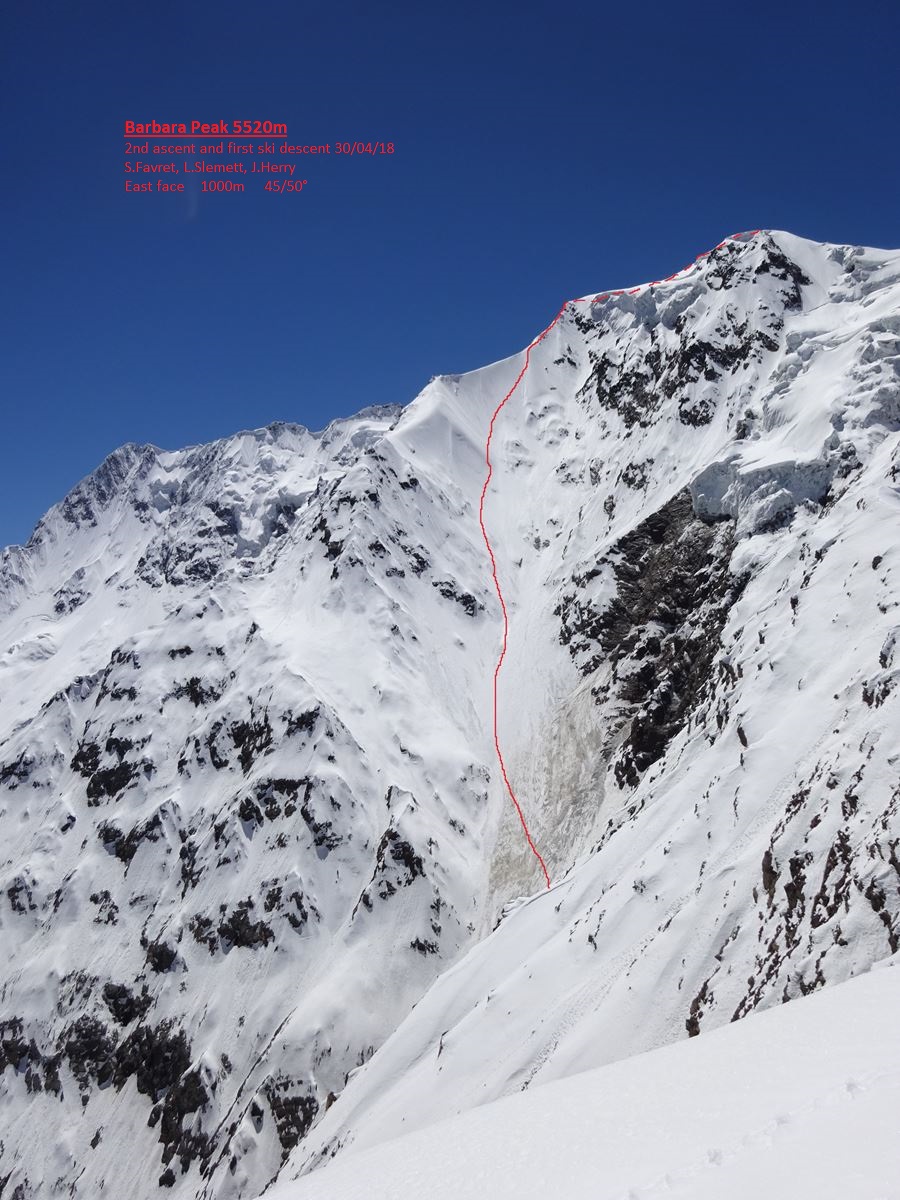
Photos: Jeremy Bernard
The spine we plan to ride is starting a bit lower but much farther from the main summit than what we thought. After hesitating a few minutes, we decide to keep going to the summit which is in fact standing at the top of a never-ending ridge. After a long hour of walking on that easy snowy ridge we finally get to the top. Our local guide Javed was the first alpinist to climb here a dozen years ago and it seems that we are only the second visitors and first one with skis. After spending 30 unforgettable minutes on the summit, we start riding the mellow final ridge that brings to a flatter glacier brutally ending in the void.
Being on sight now, we slowly get to the top of the spicier spine that appealed us yesterday when having a quick reconnaissance hike. The first 150 meters facing East are steep and the snow is already rotten so we decide to use a rope in some places to try to bring a bit more safety. Finally on the edge of the spine, the slope is not too steep but legs and mind are getting tired after this long journey. Skiers are riding their way, fast and fluid as usual, I decide to take it easy with a slower rhythm and more calculated turns.
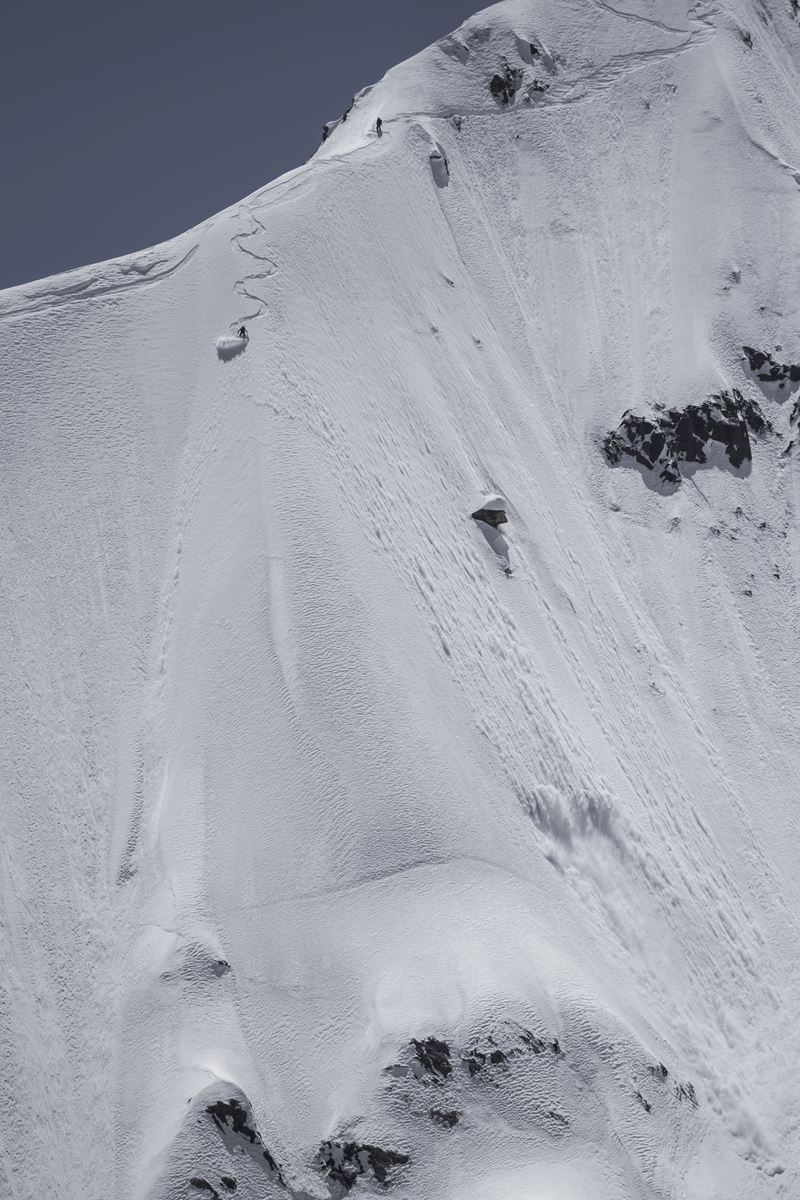
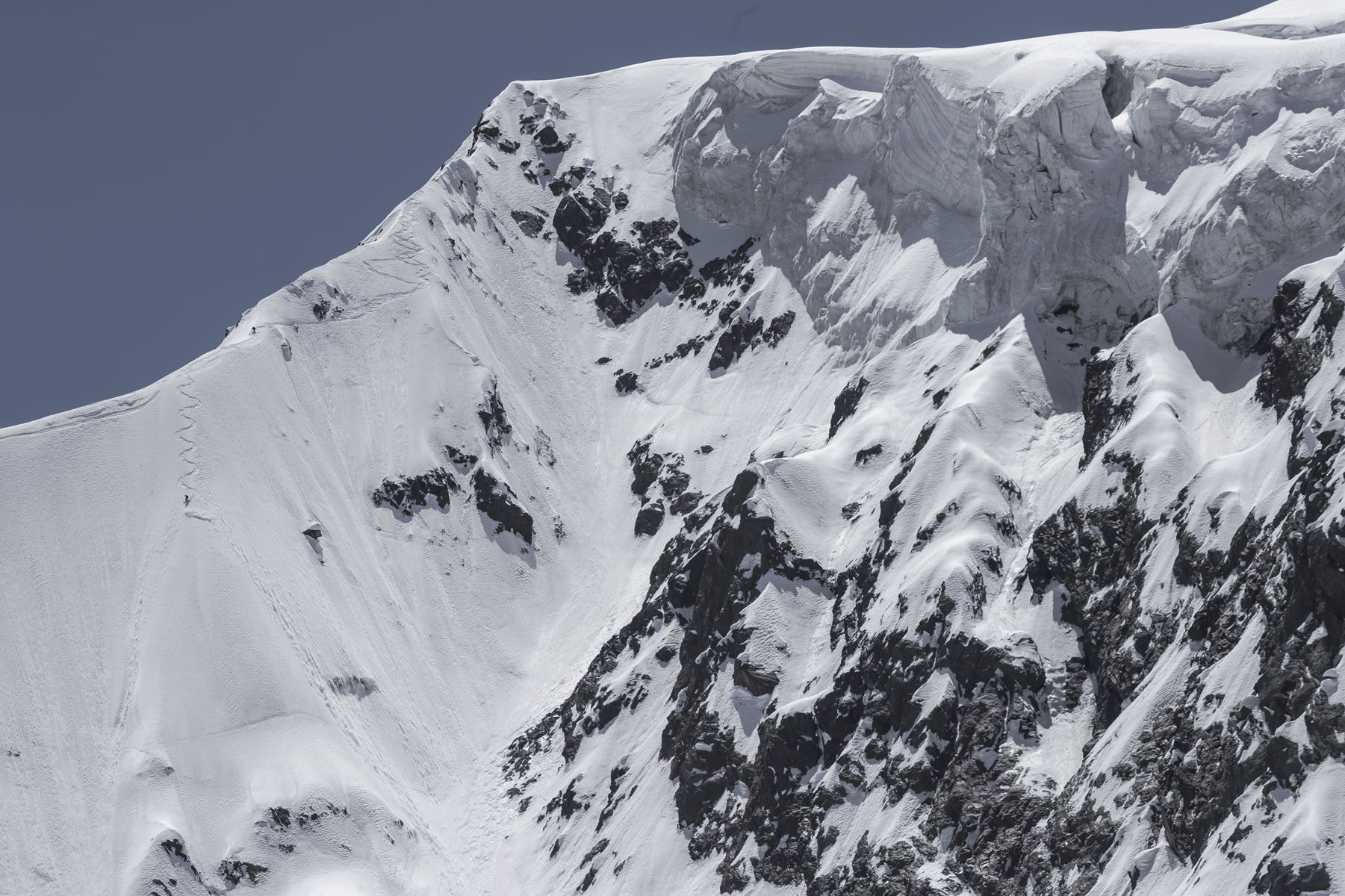
Photos: Jeremy Bernard
Soon we get to that short traverse under the gigantic seracs, the snow is becoming awful but luckily the terrain is less steep. Traversing one by one, we quickly get on the safe side of the couloir, at the bottom of an exit ramp we now have to climb. Only 100 meters to climb but it feels like hundreds on a thin layer of crappy wet snow on top of dirty rocks. Finally after at least an hour of fighting with the conditions we get to this top ridge, discovering nice powdery mellow spines on the other side before the classic corn session down to base camp where our friends warmly welcome us!
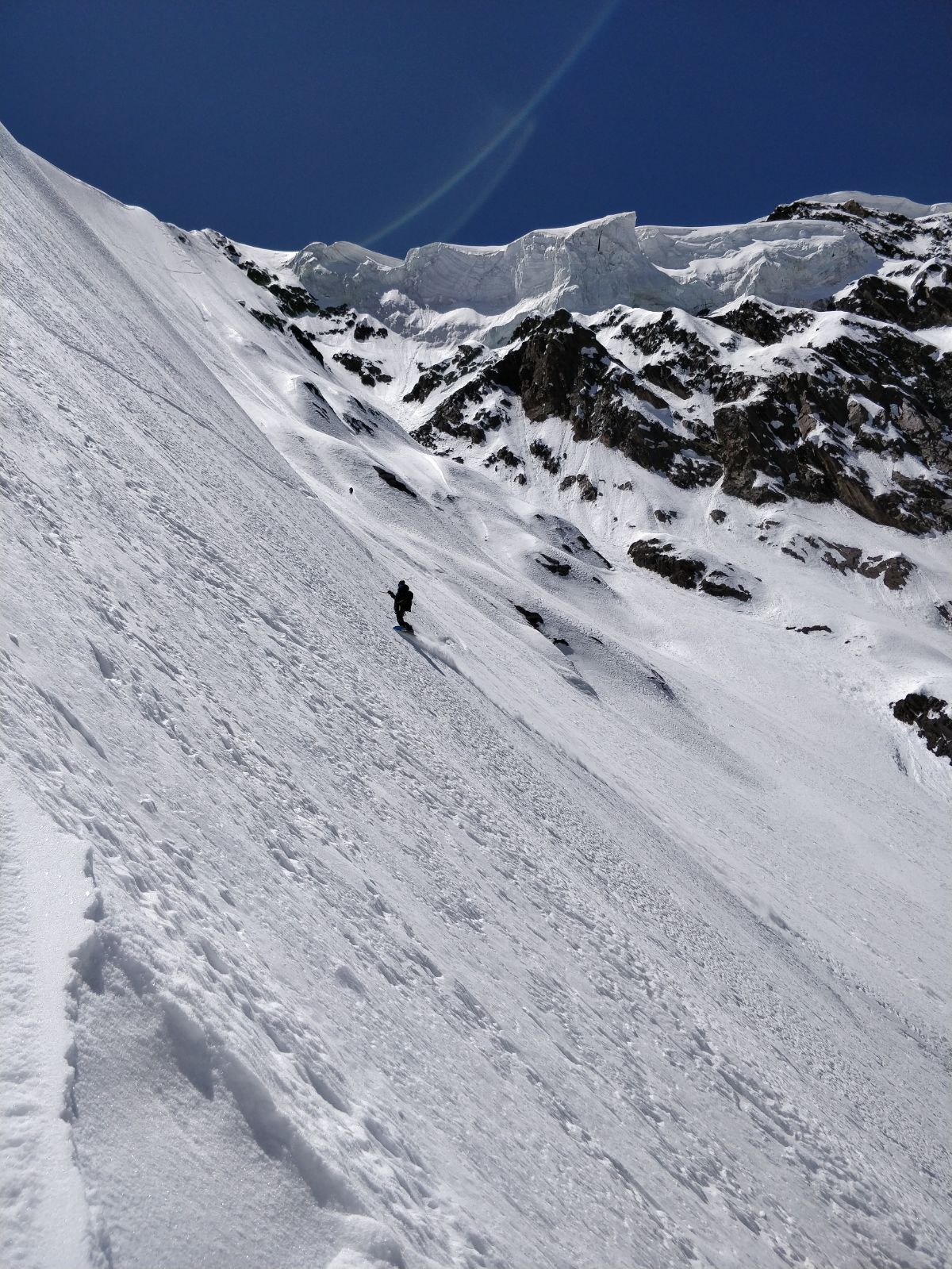
Pakistan is a big country (796 096 km2) which has a boarder with Iran, Afghanistan, China and India. K2 (8611m) is the highest summit of the country but also the 2nd highest peak in the world. The Karakoram range is located in the Gilgit Baltistan area and includes 4 summits above 8000 meters, the fifth one Nangat Parbat being part of the Himlayan range… The Hunza valley is located by the Chinese boarder and used to be part of the Silk Road, people have been travelling through this valley for hundreds of years. Baltit, recently renamed Karimabad, has always been the capital of the valley at an altitude of 2600 meters. The valley there is wide and green, contrasting with brown lower mountains and white summits. Four 7000m summits are visible from the village, Diran Peak (7266m), Golden Peak (7027m), Rakaposhi (7788m) and Ultar Sar (7388m). If you add the great local people it looks like one of the best place on earth to visit! Unfortunately after the 11/09/2001 events, the situation went from growing tourism to nothing within just a few days, forcing many local people to change their way of life. Pakistan quickly got the reputation of a dangerous Taliban country for the rest of the world and the situation lasted for the past 15 years. Luckily it seems that the wind is turning slowly now with a more stable political situation, local tourism has grown in past years like never before and more foreigners are coming every year since the 2013 massacre in Nangat Parbat base camp.
Since I met Sam a few years ago, we often talked about skiing in Pakistan. Last year came the opportunity to plan a trip with Invade media production in order to make a movie and we invited Leo Slemett to join us for this special journey.
Estelle Peak, 5465m:
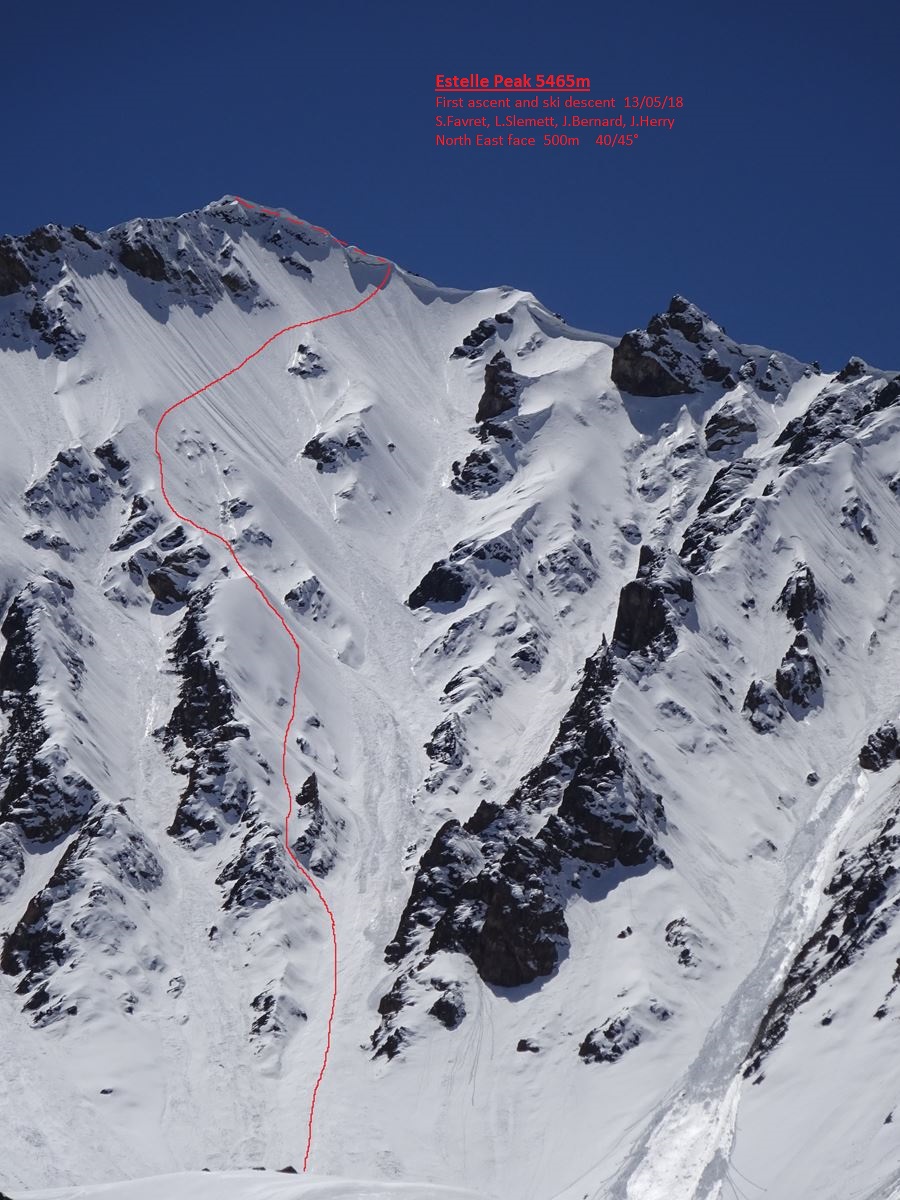
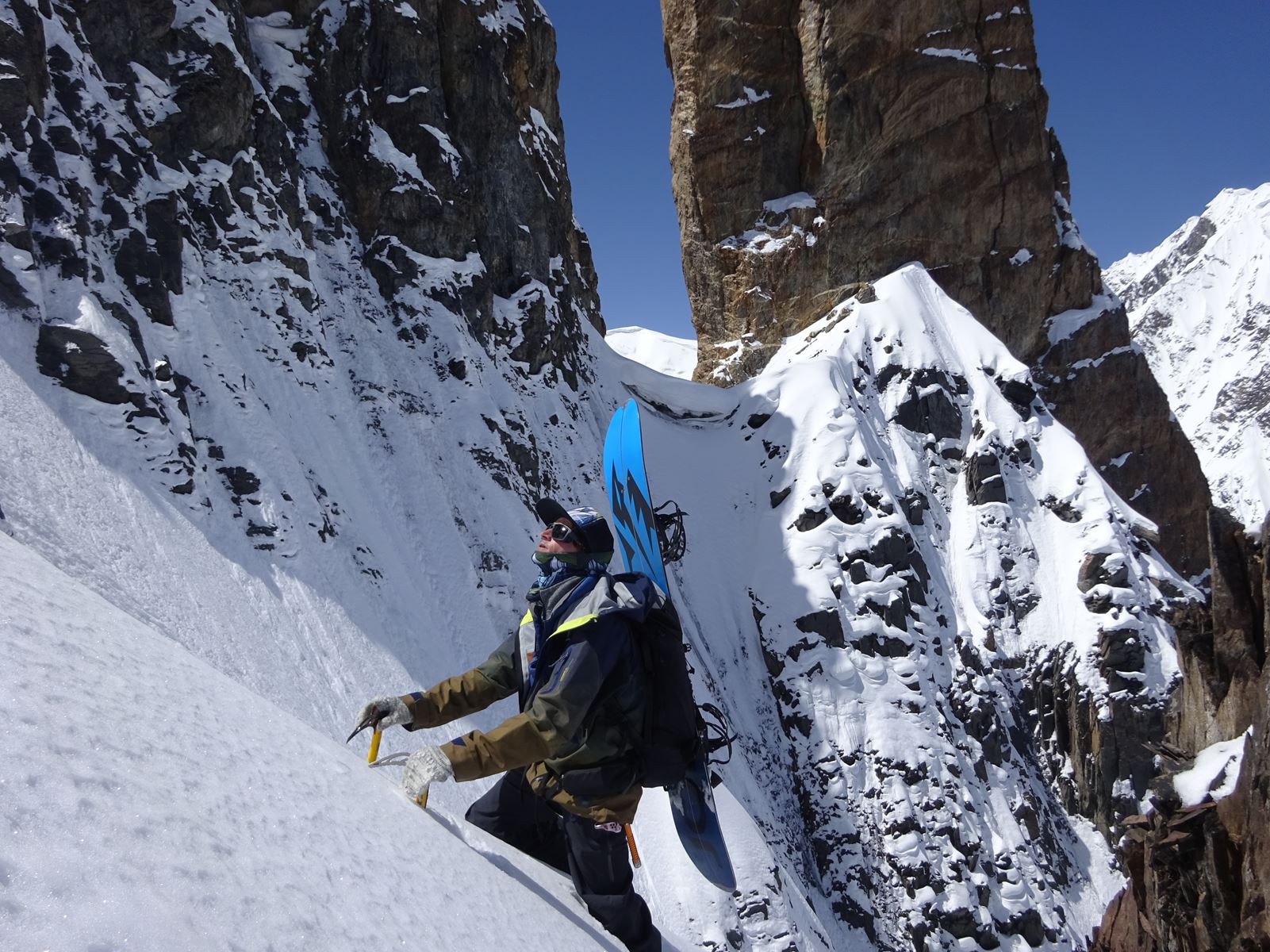
Photo: Jeremy Bernard
On the 15th of April early morning we all land in Islamabad. Sam, Leo and I are accompanied by a team of 5 people to document our journey: Jeremy Bernard (photographer), Alex Blaise (realisator), Hensli Sage (drone), JR Ceron (cameraman) and Christopher Baud (safety mountain guide)… Driving to the mountains on the Karakoram Highway is the best way to discover the country and its population! After two long but interesting days in the minivan filling our memory with amazing landscapes we arrive without any trouble in the village of Karimabad, our base camp for coming weeks… Bad weather has settled for the next four days so we have plenty of time to recover from the long travel and fill some paper work to allow us to ski and film in the mountains around.
Mashallah Peak, 4850m:
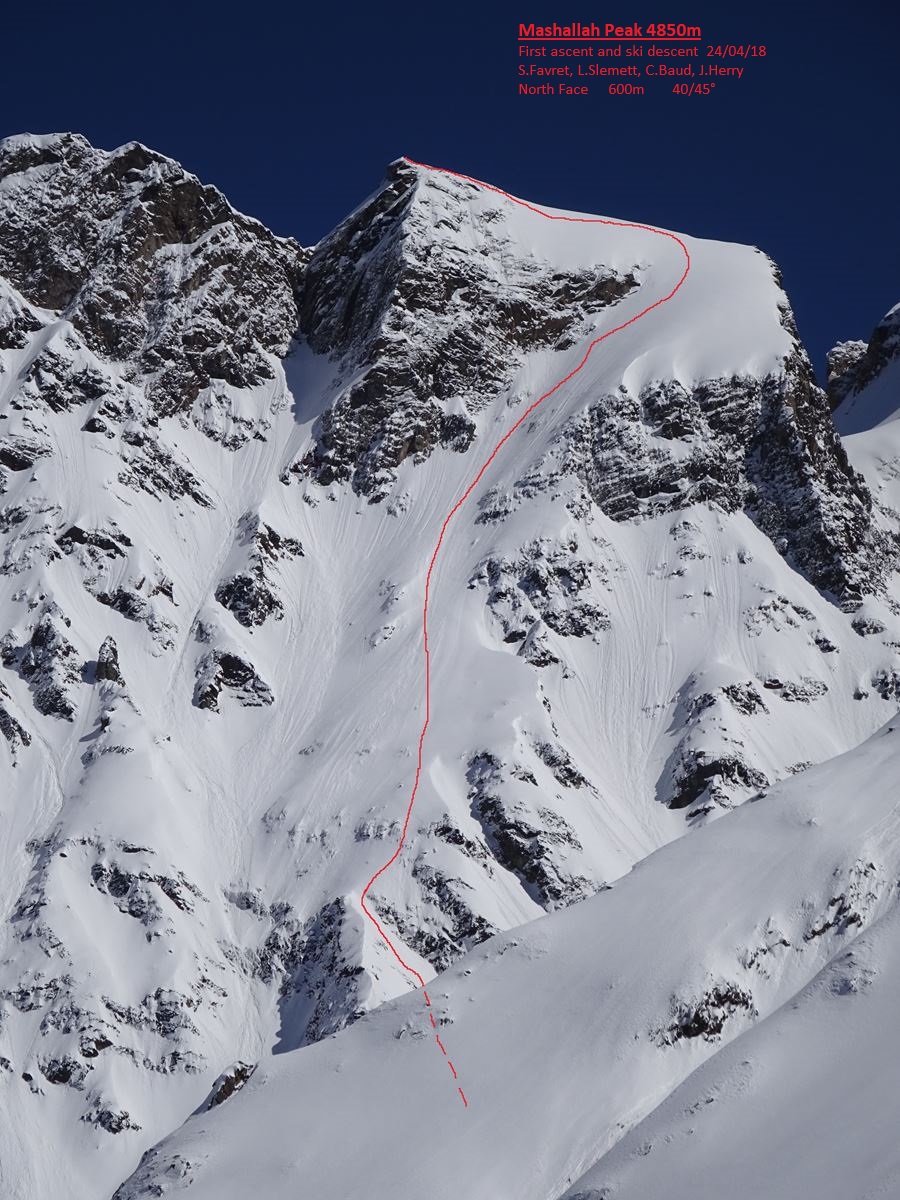
Photo: Jeremy Bernard
Getting a bit more trouble to get authorization to film with the drone and getting closer to a good weather window, we decide to go riding daily from the village to a place called Mirshikar. Only 1h45 driving from Karimabad, a short walk brings us to the snow level and endless possibilities. We spend a first day checking snow conditions after the storm and touring to 4000 meters.
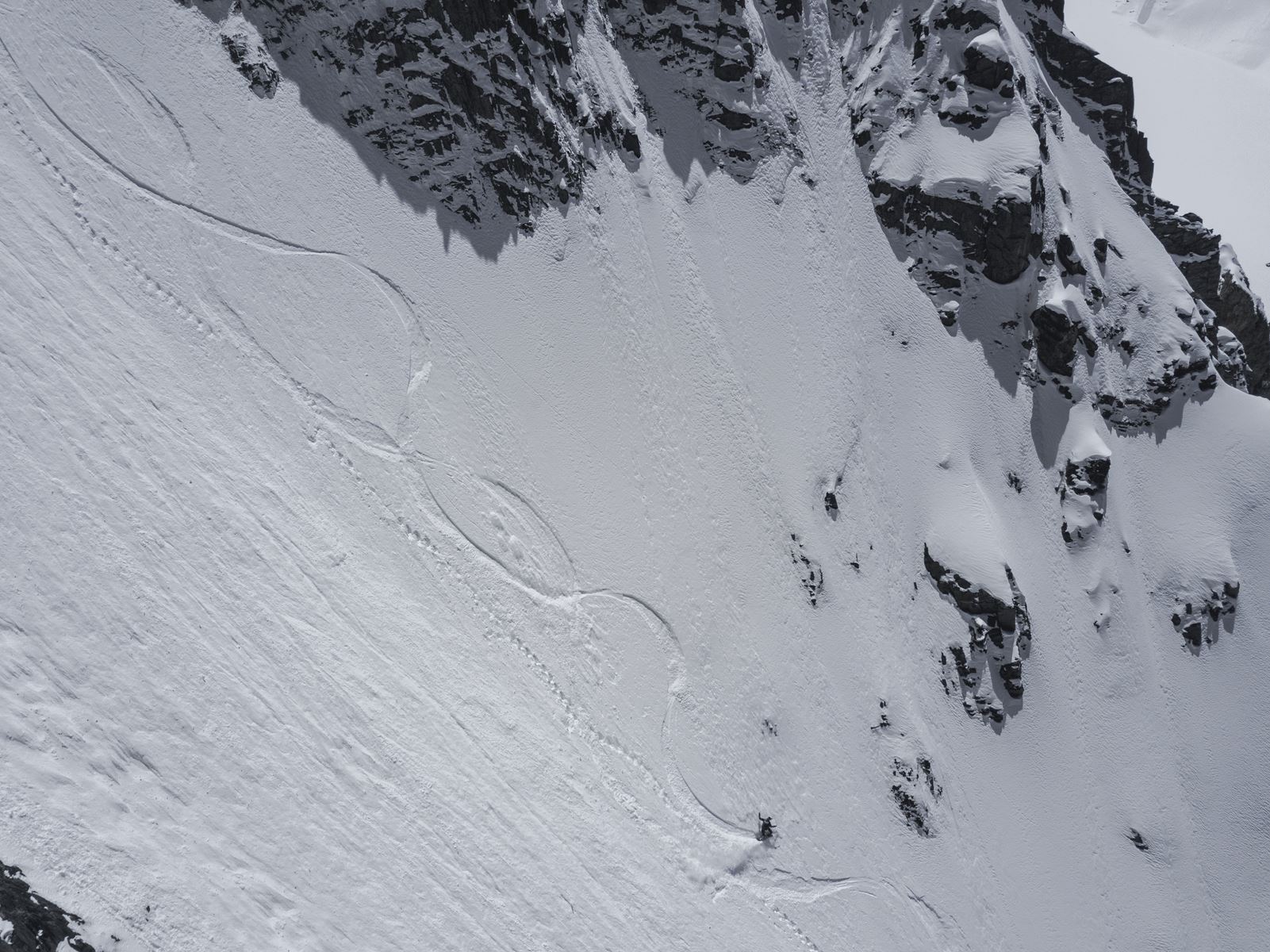
Avi risk doesn’t look to bad and first turns feel good despite a lack of visibility. Next day we leave our hotel early for a nocturnal Jeep drive before hiking on the Mirshikar main North ridge up to 4600m. From that point we ride on sight the line “Ali Akbar” that I already had the chance to climb and snowboard in 2012. The slope is pretty steep and sustained, snow is good and sluffs are big and powerful, a great first line to start our trip. After getting the authorization to fly the drone we decide to go back to the same area to set a base camp at the end of the road at 3200 meters for a few days. Taking advantage of the good weather lasting, we decide to go for a beautiful slope on the east flank of Mirshikar. Waking up early in the night, we need a few hours to get to the quick spicy traverse under huge seracs, that brings us to a safe place at the bottom of the line. After a first steep section on hard snow, we go back on a North exposition to find better and deeper snow. Finding thicker accumulations on top we decide to rope on for a few dozen meters until the final airy ridge. After 8 hours of efforts it feels amazing to stand here above the green valley, on a virgin summit at 4850 meters! Later we decide to call that peak “Mash Allah” which means beauty in Urdu.
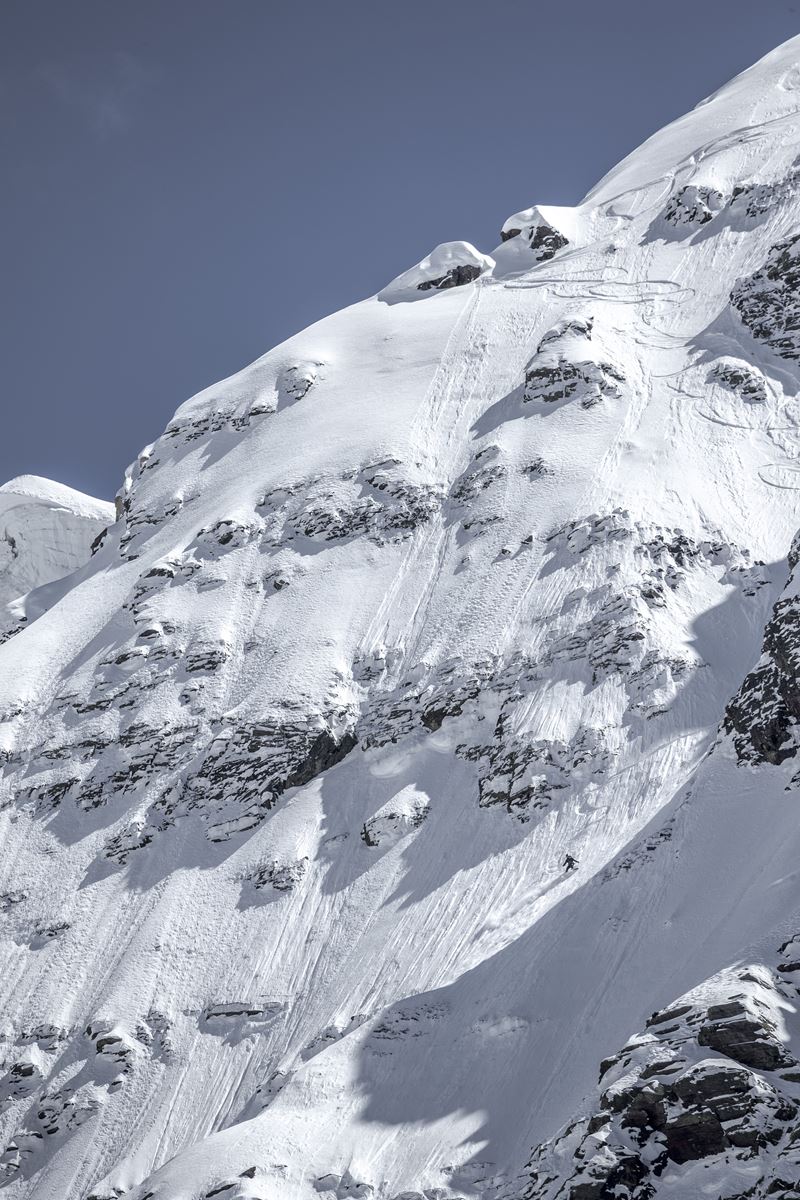
Snow is good once again and the background is simply amazing with great contrasts all around. The face is never too steep but quiet exposed above the lower cliffs, we take turn for the first track and quickly make it to the bottom of the difficulties. Follow the long traverse back to the main pass where the filming crew is waiting for us, and some great corn snow again on the way down to base camp where lunch is ready, tasty and heavy, thanks to Ali and Javed. Next day we take our chance to ride another line before bad weather comes in. Unfortunately we are too slow and tired. At the first third of the line, after 5 hours touring and climbing, we realize we are quiet late and won’t be able to make it to the summit and down before it gets too hot and dangerous. Decision making is hard but we all agree that it is not worth taking the risk. An hour later we are back at the tents, enjoying a last lazy afternoon before going back to civilization. With the weather getting unstable, we try to visit a few valleys by foot to see if there is any interest for skiing, but mainly we spend some good time in Karimabad visiting the neighboring villages and getting to know the local people better.
During the last century, the people from Hunza valley were described as “completely self sufficient, cherishing and preserving the soil, spending most of the day in the fields tending to their vegetables and fruits”. The reward of this strenuous work is a great food quality leading to an exceptional longevity with a fulfilled and healthy life. The richness of the mineral water flowing from the mountains, the varied climate, the lack of pollution, the benefits of being in altitude, and the endurance they have developed are all playing a big part in this unique longevity and healthy lifestyle. The experience taught Hunza people to give back to the soil everything they take from it, and to preserve universal knowledge and wisdom for the next generations. “
Of course the situation changed during the past decades with the Karakoram Highway bringing more cars, city food and habits, and foreigners but still Hunzas people can be self sufficient and they keep educating their kids to live in harmony with the nature and to have a great respect for it.
Zamendar Tower, 5430m:
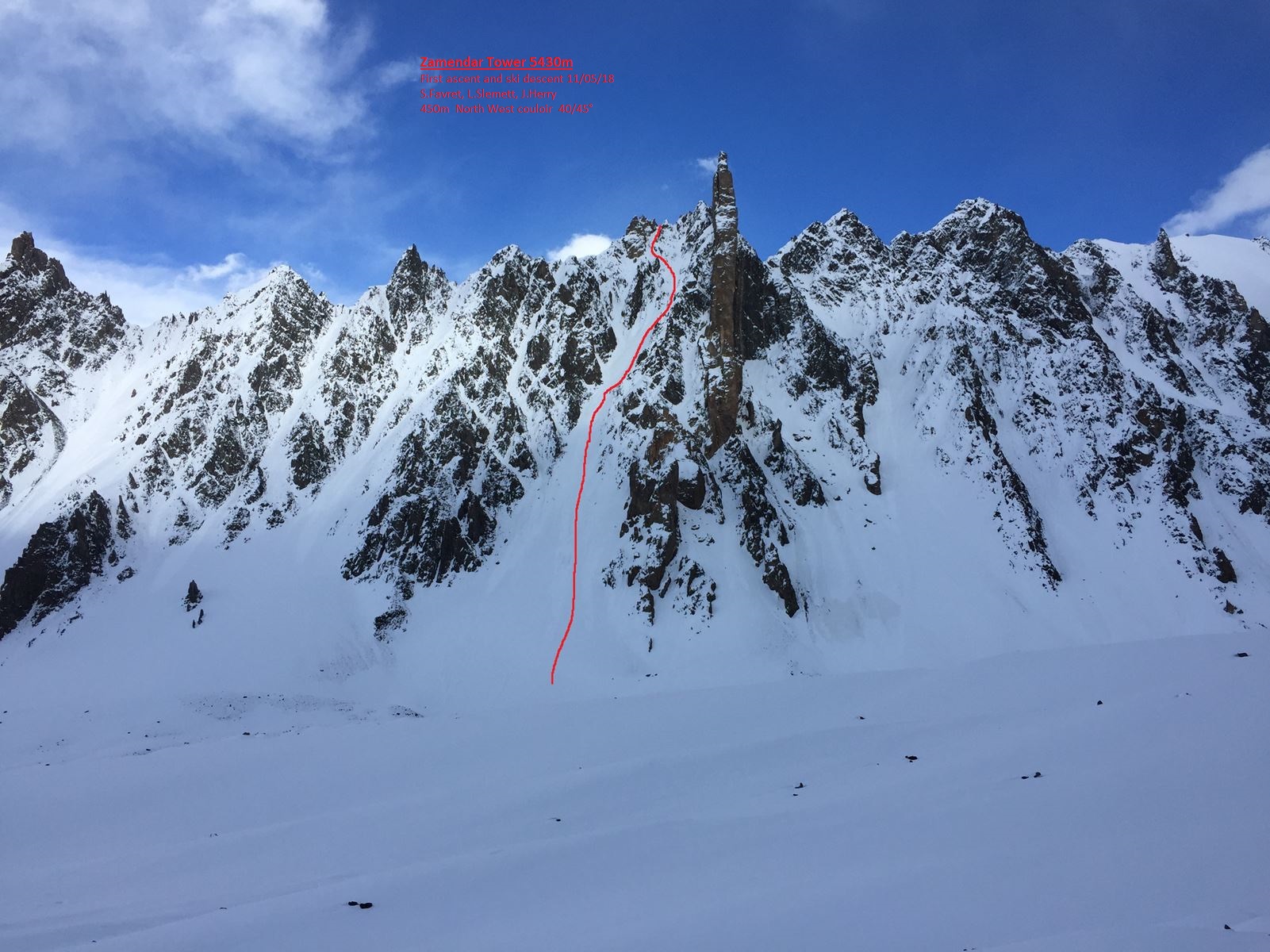
Photo: Jeremy Bernard
Earlier in the winter spending some time on Google Earth I found an interesting area a bit further North, closer to the Chinese boarder. The approach with porters didn’t look too long and the valley above looked really promising with 6000 meters summits rising at the top of the glacier. Unfortunately we quickly understand here that it will be complicated to get an authorization with this new Sea pack agreement signed between China and Pakistan. China is investing a lot of money in the KKH to provide a better access to the sea for Chinese exportations, involving an almost total control of what is happening in the valley, and restricting a lot of activities and areas. So Javed advises us to go visit that place first without skis in a day trip from Karimabad. His main concern is about traversing the Hunza river as the Karakoram Highway is on one side of the river and our valley on the other side. Being now aware of this problem, we decide to pack extra gear in case we need to install a zip line above the water. But after a more precise look on Google Earth, we imagine what could be a bridge across the river just at the entry of the valley, Inch Allah! Starting from Karimabad by night, we drive 3 hours on the KKH to ridge the entry of the Khunjerab national Park where the military guards allow us to spend a day visiting the park. A bit later, the bridge is here and we get confirmation from a shepherd that this is the valley we are looking for on the map. He tells us to follow a path leading to a spring and then a shepherd house, and that we are the first foreigners to ever visit the area. After an hour of walk we arrive at the spring and are able to see the first skiable lines. An hour later we are at the base of the glacier, on a huge flat area with grass that looks perfect for a base camp. The potential ahead looks enormous and we are all excited on the way back to the minivan. Now we just need to get authorizations to camp there for a few nights. A few days of paper work and negotiations later, we are finally allowed to spend 5 days up there with an obligation to respect wildlife and leave nothing except ski tracks. After a night in Sost, the last big village on the road, in order to find porters, we finally start hiking from that precious bridge with all the gear early in the morning. At mid day we all ridge base camp at 4400 meters and decide to skin up a bit on the glacier to check the potential of that valley from closer. After 2 hours between walking and touring, and despite a deteriorating visibility, we are close enough to find a target for the next day.
Skiing a virgin 6000m peak sounds pretty exciting and is appealing us. Leaving base camp in the night, the daylight catches us at the bottom of the couloir. The first part is mellow with good compacted snow that allows a bit faster progression. But soon the sun comes out and the snow gets deeper. It quickly gets pretty hot in this East facing couloir and after climbing 2/3 of it we realize that we have huge snow mushrooms hanging above the next part of the climb, that we couldn’t see unfortunately the previous day with the flat light. After hesitating for half an hour we decide to play it safely as the snow is getting heavy too quickly as well. Still we enjoy riding the few hundred meters we just climbed and after meeting filming crew on the glacier, we glide back together to base camp for a rest afternoon.
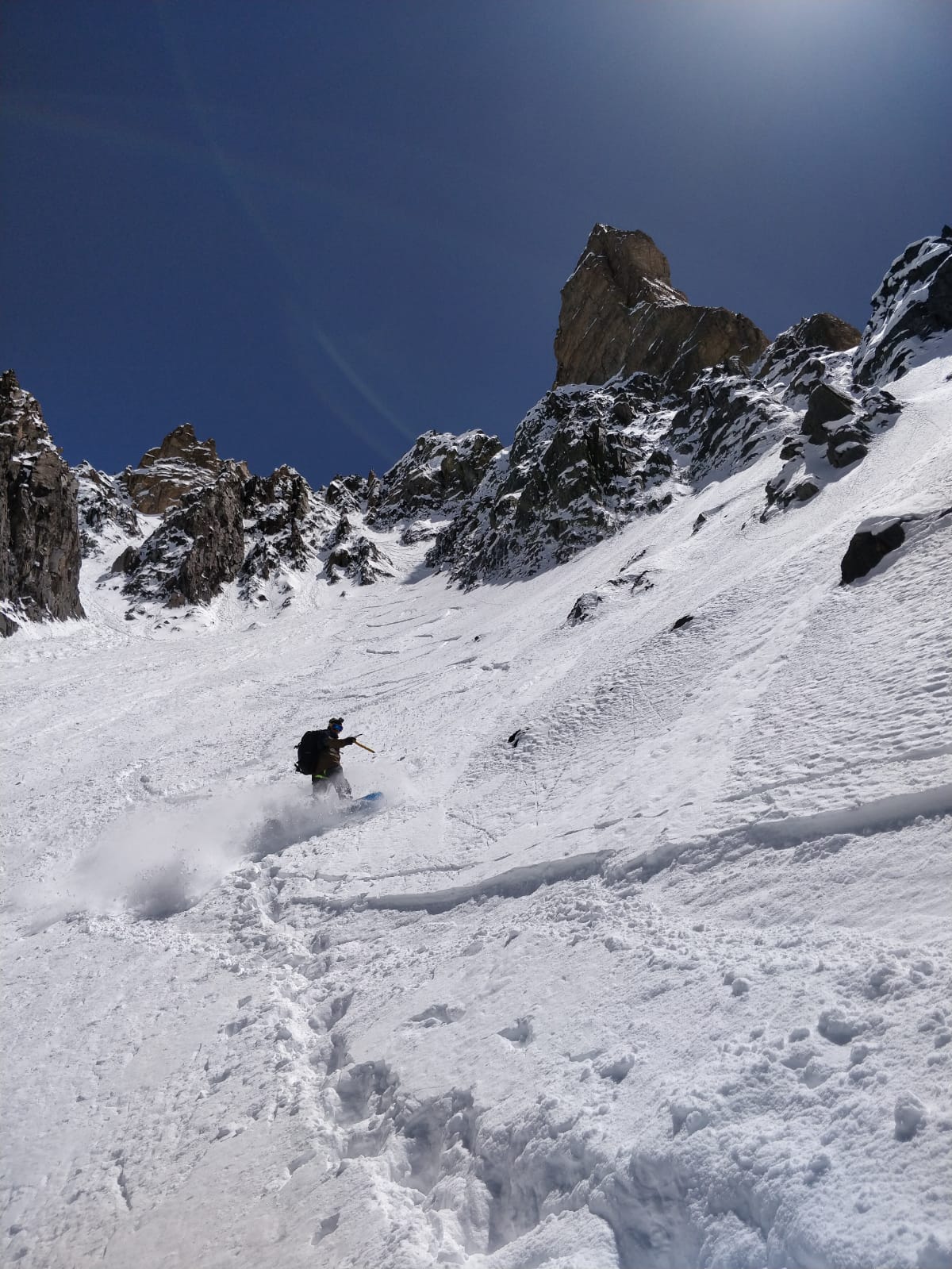
Photo: Jeremy Bernard
Not knowing exactly when that good weather window would end, we decide to try our chance again the following day. After 2 tiring days in a row, we choose a bit shorter couloir we name “Zamendar couloir” because it is surrounded by a huge granite pillar. Facing more West, we can have a later start as well. The approach feels longer every day and after 3 hours we are happy to switch skis for crampons. The icy snow leaves place to nice powder when the couloir gets steeper and we keep moving slowly under the eye of that giant granite guardian. Last steps get a bit tricky with sugary snow on the rock but we quickly ridge the top around 5450 meters. All these mountains look much bigger now than on the maps, there are so many mountains to ski in this area as well. After contemplating the landscape for a few minutes, we rappel down that top sugary section to get on more skiable terrain. Snow is mostly good and the ambiance is pretty unique, we are feeling grateful after the previous day Demi tour. Following morning we are not able to get up, we are just too tired. Despite feeling a bit guilty with the weather remaining good, we enjoy an easy day at our peaceful base camp. On the 5th and last day, before the porters come to pick us, we manage to climb and ride a nice virgin summit we called “Estelle peak” just above base camp.
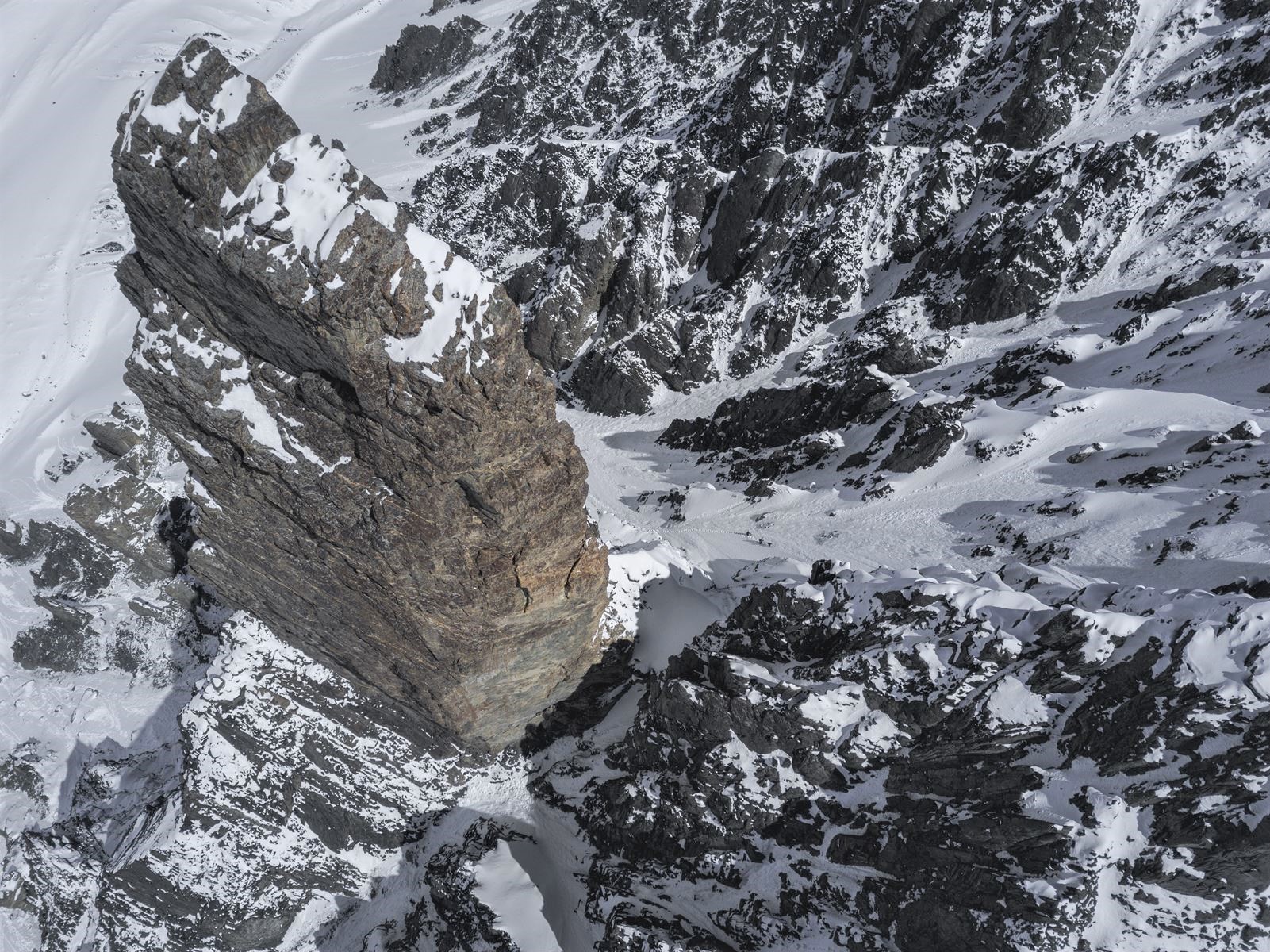
Photo: Jeremy Bernard
Unfortunately except the short window on the summit at 5400 meters, we spend the day with poor visibility, but manage to end our trip on a great line. Weather remains unstable during following days so we just appreciate the easy tourist life in the Hunza valley before the long way back home!
The Karakoram Range proved once again to be a unique place for riding with snow conditions comparable to what we find in the Alps and a never ending playground. Add the most beautiful mountains in the world disposed in a rare density and surrounded by unique valleys, I call it a paradise! As usual we found great people in the mountains but Hunza people really inspired us with their richness of life, simplicity and longevity with little impact on their unique surrounding environment!
See the full Hunza Documentary here: https://vimeo.com/ondemand/hunza
